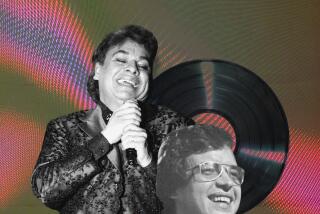Grammys 2013: A magical year for <i>son jarocho</i>This year, three groups infused with the genre of ‘Mexican blues’ that’s built musical bridges between L.A. and Veracruz state are up for Recording Academy awards.
Last week, a group of Latino and Mexican artists up for three Grammy Awards gathered in a narrow Boyle Heights storefront — mostly in the flesh, some via Skype, a few present in spirit.
They’d assembled to honor a strain of regional folk music nicknamed “the Mexican blues” that generations of L.A. musicians have stamped onto their DNA but that until this year the Grammys had largely ignored.
The music, son jarocho (pronounced ha-RO-cho), is a hothouse hybrid of baroque Spanish instruments, ferocious Afro-Caribbean beats, Native American poetics and wise-cracking wordplay that Iberian conquistadors and black slaves imported to the tropical Mexican state of Veracruz.
PHOTOS: Top nominees | Snubs & surprises | Nominations concert | Full coverage
Quetzal Flores, cofounder of the politically minded, jarocho-influenced East L.A. funk-rock ensemble Quetzal, whose album “Imaginaries” is competing for the Latin rock-urban-alternative album Grammy, had convened the gettogether at Guadalupe Custom Strings, a boutique crafter of cords for jarocho instruments on a busy stretch of Cesar Chavez Avenue.
For the dozen or so musicians who showed up, the charla was a symbolic and highly emotional reunion.
“I swear I am trembling in my tennis shoes right now because this is exciting to me,” said Louie Pérez, who with his Los Lobos bandmate David Hidalgo began fusing delicate jarocho textures with crunching Chicano rock in the early 1970s, and has collaborated with several of this year’s Grammy contenders. “We were rock dudes, and something happened when we discovered Mexican music. Jarocho music, for us — that rocked. It had that raw energy that we didn’t find anywhere else.”
In recent decades, California in general, and the Los Angeles region in particular, has played a vital role in preserving and extending jarocho‘s sonic legacy when the music was in danger of withering into obscurity outside of Mexico.
Ritchie Valens, the L.A. native and Spanish-language rock pioneer, scored a timeless Top 40 hit in 1958 with his rock ‘n’ roll cover of the jarocho classic “La Bamba.” Today, the members of Los Lobos are the elder statesmen in a long line of L.A. musicians who’ve embraced jarocho‘s emphatically rebellious aesthetic, from Ozomatli and Zack de la Rocha to younger acts such as La Santa Cecilia and Las Cafeteras.
VOTE: Grammy awards play-at-home ballot
“Los Angeles, for lack of a better word, it’s sort of a mecca for son jarocho,” said Betto Arcos, a native of the Veracruz capital of Xalapa and organizer of the 12-year-old Encuentro de Jaraneros (Encounter of Jarocho Musicians) in Los Angeles, one of California’s largest annual such festivals.
This year, for the first time, the Recording Academy has taken serious notice of the genre, nominating Quetzal and two other groups with strong jarocho pedigrees: Los Cojolites, a traditional ensemble from Jáltipan in southern Veracruz that’s been performing in L.A. for years and contributed to the soundtrack of Julie Taymor’s biopic “Frida”; and Sistema Bomb, the artistic moniker of L.A.-bred, Bay Area-based producer-composer Hector “Hecdog” Pérez, whose solo debut album, “Electro-Jarocho,” re-interprets jarocho through the filters of hip-hop, pop and electronic dance music. All are first-time Grammy nominees.
Among the artists who collaborated on “Electro-Jarocho” are Los Cojolites, Asdru Sierra of L.A. hometown hip-hop/funk heroes Ozomatli, and Roco Pachukote of the Mexico City rock band Maldita Vecindad. As with other artists on both sides of the border, they’ve found novel ways of folding jarocho‘s biting witticisms and fiery polyrhythms into their own distinctive sounds.
“There is a certain resonant feature of this music that hits a lot of Chicanos,” said Hector Perez, who grew up in South L.A. and played drums in his Mexican-immigrant father’s band at parties and weddings. “If you’ve been to any quinceañeras or bodas as kids, there’s elements of all that music that you’ll find in son jarocho. So you add that to the pozole, you can see why this seems to be a magical year for son jarocho.”
Son jarocho has a complex, centuries-long history spanning a hemisphere. But its twin poles — building community and challenging authority — have never changed.
The irrepressible sound emanates from small guitars, harps and congas, accompanied by the eerie scrapings of quijadas (donkeys’ jaws) and the aggressively sensual patter of fandango dancers pounding a wooden platform called a tarima. When performed outdoors in public spaces, it can erupt into wild, jazz-like improvisations, reinforcing tribal and political bonds while tunefully extending a raised fist to the powers that be. The Spanish Inquisition tried to ban it.
Greg Landau, a Bay Area producer and co-owner of Oakland’s Round Whirled Records, who with Hector Perez co-produced Los Cojolites’ album “Sembrando Flores” (Strewing Flowers), said jarocho has “that same kind of energy of punk” that “captures this essence of cultural resistance that’s been going on for hundreds of years.”
Over the last several decades, that combination of political engagement and artistic cooperation has infused a growing connection between jaraneros (jarocho musicians) in California and Veracruz. Flores, Quetzal’s leader, said the relationship really began to blossom in 2002, when the venerable Mexican jarocho groups Son de Madera and Mono Blanco performed in Los Angeles.
That has fostered an evolving two-way cultural exchange in which musicians from both countries have studied and jammed with one another frequently and assimilated one anothers’ ideas.
“The seeds that groups like Los Lobos, Ozomatli, Quetzal planted years ago I think is partly responsible for what is occurring now,” said Perez of Sistema Bomb.
Winning a trophy may be hard for this year’s three jarocho-centric Grammy nominees. Quetzal and Sistema Bomb are contenders in the Latin rock, urban or alternative album category, whose other hopefuls include the soulful Chilean rapper and critics’ darling Ana Tijoux.
Los Cojolites is the first group to be nominated in a category — regional Mexican music album (including tejano) — usually dominated by mariachi, norteño and banda groups . It’ll be facing brand-name performers such as Los Tucanes de Tijuana and Lila Downs, the eclectic Oaxacan American artist whose rich, sonic tapestries also incorporate jarocho.
But although the three groups are grateful for the nominations, they insist that the outcome of Sunday’s ceremony scarcely matters. “We have been doing things for 17 years, and we haven’t been thinking of winning prizes,” said Benito Cortés Padua of Los Cojolites, speaking by Skype from Mexico.
What’s more significant, they said, is continuing the cross-border commitment to an antique but still-evolving art form.
“We’re so connected to one another on an entirely different level from what the mainstream sort of puts out there or sees or acknowledges,” said Flores, the son of farmworker-organizer social activists.
“For me, the prestige comes not from being nominated for a Grammy but from being connected to all these people here,” he added, nodding at his friends standing shoulder to shoulder in a little shop in Boyle Heights.
PHOTOS AND MORE
COACHELLA: Complete 2013 lineup
THE ENVELOPE: Awards Insider
PHOTOS: Grammy top nominees
More to Read
From the Oscars to the Emmys.
Get the Envelope newsletter for exclusive awards season coverage, behind-the-scenes stories from the Envelope podcast and columnist Glenn Whipp’s must-read analysis.
You may occasionally receive promotional content from the Los Angeles Times.







